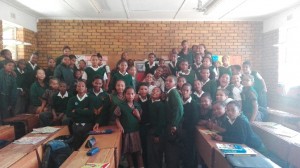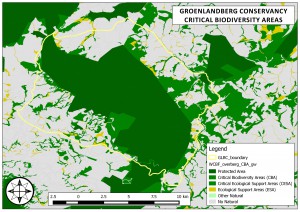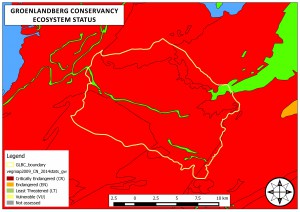Fire Awareness Education
The Groenlandberg Conservancy in collaboration with the Table Mountain Fund, World Wildlife Fund, CapeNature and Working on Fire are performing exciting Environmental Awareness Campaigns to schools and communities in Villiersdorp, Grabouw and Botriver. The aim of these clear and concise programs is to create awareness around the importance of biodiversity, wonder and value of ecosystems, habitat destruction of invasive species, illegal activities in the Groenland mountains and the crucial awareness of the dangers of uncontrolled wildfires.

Fig 1 De Rust Primary School visit.
The activities range from school visits, guided hikes, door- to- door campaigns, information stands, teacher training workshops and attending meetings regarding fire. The Facebook page “Groenlandberg Conservancy Fire- and Environmental Awareness Education” are also well underway and received 136 likes to date, where each event is posted for community members to follow our progress and success. Our results thus far to date range from interacting with 12 schools reaching 3 864 learners with our school visits and engaged with 508 community members with our door- to- door campaigns dealing with water conservation and fire awareness. We look forward for 2017 to create a conservation conscious Groenland!
Welgemoed – anyone for worm tea?
Farming principally apples and pears, Welgemoed is a large farm situated on the Vyeboom side of Van der Stel Pass. Owner Garry Southern is passionate about the landscape and the importance of keeping a piece of South African land in his family. Conservation minded, it’s refreshing to find a farmer prepared to invest in alternative and more sustainable ways of farming. His approach to nurturing and feeding his orchards is living proof of his philosophy.
Welgemoed produces and feeds their orchards 500 liters per hectare of worm tea a week. It’s a system that has been well researched and is clearly producing results. Apart from saving 30% on fertilizer costs, the worm tea also suppresses diseases and fungal infections.
Worm tea is a highly concentrated liquid, high in essential nutrients such as nitrogen, calcium, potassium and phosphate, but also containing all the healthy microbes that plants thrive on. Immediate benefits aside, by consistently applying the tea as you would any other fertilizer, you actually improve and rehabilitate the overall nature of the soil, producing a far healthier orchard in the long term.
Garry recounts the story of a diseased block, the vermitea appears to have corrected much of the problems in the roots of the Braeburns. Six years after being advised to pull out the trees in that orchard, the farm is still getting over sixty tons a hectare despite that orchard now bring in its 26th year.
The operation is set-up in a large shed, water is pumped and leached through the wormeries, carrying nutrients and all the goodness of Vermicast with it. The tea filters into a large underground tank where it is stored until it is added straight into the irrigation system once a week.
With consumers demanding a shift away from many dangerous and harmful chemicals that get used in farming, it’s uplifting to find a farm that isn’t afraid to explore alternatives.
The introduction of worm tea seems small but has far reaching effects. Welgemoed is restoring the health of their soil, ensuring strong orchards, a sustainable eco-system and a healthy crop. It impacts on overall biodiversity and that is inspiring, hopefully a trend we start seeing more of in our area soon.
Launch of the Man and the Biosphere: Kogelberg Biosphere Reserve Coin Series.
This week was a very special one for our area, on the eve of heritage day SA Mint in collaboration with the Kogelberg Biosphere launched a series of commemorative coins celebrating a journey through one of the most beautiful areas in South Africa, our very own Kogelberg.
The launch ceremony took place at the Waterkloof Estate, with magnificent views across the reserve. As part of the many invited to represent the area, I felt tremendously proud of this incredible part of the world we get to call home. The collection included four gold and silver coins beautifully illustrated with well-researched scenes from the reserve.
My favorite was of course the Silver R2 coin depicting the Elgin Valley, featuring the honey bee and orchard fruit (above right).
“Queen Kogel” Joanne Strauss beautifully adorned in Okasie outfit and headdress was a charming hostess. We learnt a great deal about the UNESCO Man and the Biosphere Program passionately and cleverly explained by Johan West (chairman of the KBR) and Dr Ruida Pool-Stanvliet.
Lunch served a creative array of local produce paired with Waterkloof Wines.
All in all, a truly uplifting and inspired occasion, a showcase of our rich fauna and flora and a fantastic advert for our area. The coins will no doubt continue to carry the message and attract an even greater interest in this magnificent part of the world.
Conserving our Global Biodiversity Hotspot
We were honored to have Cape Nature’s Keir Lynch address Conservancy members and visitors at Fruitways on 14 May. We had a full house of dedicated conservationists who braved the cold and dark (we had load-shedding at the time) to hear Keir address something close to his heart – the fundamental role conservancies play in conserving our area.
Keir displayed his deep knowledge of endemic and endangered species to highlight how precious and threatened our biodiversity is. Through an impressive selection of maps, he highlighted the key role conservancies (the Groenlandberg Conservancy in particular) plays. Here are a couple of his maps that show how important the natural resources of the Groenlandberg Conservancy are.


The second map shows the Conservancy’s Ecosystem Status as being Critically Endangered.
Keir’s passion and knowledge certainly brought home the importance of the work the Conservancy is doing. He highlighted how important our contributions are and how our participation and belonging is the only thing that can save our natural and threatened ecosystems through preserving this Biodiversity Hotspot


